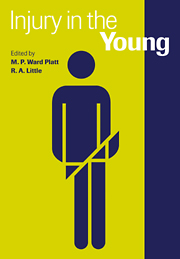Book contents
- Frontmatter
- Contents
- List of contributors
- Editors' Preface
- 1 The epidemiology of trauma involving children
- 2 Emergency room requirements for children
- 3 Child deaths in Accident and Emergency
- 4 Immediate life support
- 5 Evaluation of injury in children
- 6 Injuries of the developing brain
- 7 Wound healing in children
- 8 The lung after injury in children
- 9 Metabolic and endocrine stress responses to surgery
- 10 Head injury in children
- 11 Near drowning
- 12 The acute response to burn injury in children
- 13 Nutritional support of the severely burned child
- 14 Recovery, rehabilitation and the neuropsychological sequelae of head injury
- 15 Children's rights and child protection
- Index
1 - The epidemiology of trauma involving children
Published online by Cambridge University Press: 18 September 2009
- Frontmatter
- Contents
- List of contributors
- Editors' Preface
- 1 The epidemiology of trauma involving children
- 2 Emergency room requirements for children
- 3 Child deaths in Accident and Emergency
- 4 Immediate life support
- 5 Evaluation of injury in children
- 6 Injuries of the developing brain
- 7 Wound healing in children
- 8 The lung after injury in children
- 9 Metabolic and endocrine stress responses to surgery
- 10 Head injury in children
- 11 Near drowning
- 12 The acute response to burn injury in children
- 13 Nutritional support of the severely burned child
- 14 Recovery, rehabilitation and the neuropsychological sequelae of head injury
- 15 Children's rights and child protection
- Index
Summary
Injury is disruption to the structure or function of the human organism resulting from exposure to excessive or deficient energy, regardless of intent (Baker et al., 1992). Traumatic injury is associated with acute transfer of environmental energy to the body in quantities beyond the ordinary limits of homeostasis to the point where the integrity of the organism is breached. This energy may be mechanical, chemical, thermal, electrical or through pressure waves (trauma therefore excludes suffocation/drowning and poisoning injury).
There is no clear minimum energy transfer or degree of ‘injury’ to define where for instance a bruise, graze, sprain or scald might result. There are methods, however, to categorise the severity of traumatic injury which are intended to be related to this original energy transfer, but which are usually calibrated by their ability to predict case fatality (e.g. Injury Severity Score, ISS (Baker et al., 1976), Revised Trauma Score (Champion et al., 1989), Combination = TRISS). These injury severity scales are among a number developed for rapid field triage, for casemix standardisation in trauma care resource use/outcome studies, or as prognostic indications during intensive treatment (MacKenzie, 1984). More recently the ISS has been used to disaggregate incident cases in epidemiological studies (Walsh et al., 1996).
An important element in the future development of such injury severity scales will be their recalibration by the ability to predict non-fatal outcomes such as short-term impairment or longer term functional incapacity (Chapter 14).
- Type
- Chapter
- Information
- Injury in the Young , pp. 1 - 9Publisher: Cambridge University PressPrint publication year: 1998



